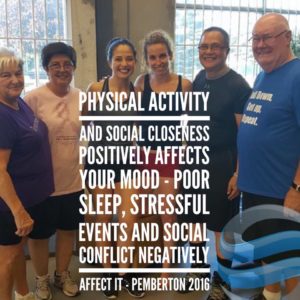Over the last several decades, a tremendous amount of work has gone into reducing the stigma around mental illness. This is a topic near and dear to my heart as mental illness has affected my family and I am very aware of my own mood because of the family history.
Depression generally refers to a low mood, irritability or sadness that stays for at least a two-week span. Treatment for depression has gotten better. Medications have evolved over time, therapies have been developed and defined like cognitive behavioural therapy or CBT. I am by no means an expert on any of these.
However, there is also one therapy that has been shown time and time again in the research to HUGELY improve the signs and symptoms of depression for those diagnosed with clinical depression and for those in a tough time in their life where their mood is lower than it usually is.
It’s EXERCISE!
This first came to my attention in a 4th year class that I took in my undergrad. It was called Exercise and Mental Health. I read a book by Dr. John Ratey called Spark. This book is phenomenal and described research studies where exercise was just as effective if not more effective than medications. When used as a combo – exercise + medications the results were even better!
Exercise’s effects seem to span the lifespan. With strong evidence to support it’s benefit for people of
all ages. A recent meta-analysis (seen as the strongest type of research) showed that exercise had a moderate to large effect on depression compared to a control group. Medications can take 2 weeks to see an effect. The effect of exercise can be immediate! There is also data to show that people who exercise are less likely to get depressed in the first place. I really do believe that because I am active, I haven’t had depression. There have been times in my life where a lot of negativity and stress has surrounded me. I got low and exercise was HARDER but I kept at it. It really helped.
But here’s the thing that I think is really difficult. When you are feeling low – getting off the couch or waking up earlier to exercise is really, really hard! When my stress sky rockets, I just want my exercise to plummet. I feel weaker, slower, moving seems more of a chore. I completely get it.
Here’s are 4 things that I try to make myself just do it anyway.
1. Get moving in the morning. It is SO easy to just say “oh I’ll go to the gym after work”. It doesn’t happen. Work gets busy. You end up working later than expected. A family member calls needing something. It becomes really easy to get un-motivated.
2. Even if you don’t want to – tie up your running shoes. I have had days where I am going for a run and as I’m tying up my shoes… I’m thinking I really don’t want to do this. That’s okay! That’s normal! Sometimes on those days I end up running much slower. But I never regret getting out the door.
3. Go outside. Rain, snow, humidity, you name it – go anyway. The power of being outdoors on your mood is incredible. It makes you feel better. Once you get that little boost, convincing yourself to move a little bit more gets easier.
4. Make someone else drag you. We all have that friend who is a little bit (or a lot) more motivated to exercise. Make them your accountability. Just don’t get mad at them later if they actually do push you! It comes from love!
Take it one day at a time. If you didn’t quite make it yesterday, that’s alright. Try again today. Life is an accumulation of tiny efforts. You’ll be thankful that you did!
References:
Adamson, B. C., Yang, Y., & Motl, R. W. (2016). Association between compliance with physical activity guidelines, sedentary behavior and depressive symptoms. Preventive Medicine, doi:S0091-7435(16)30226-2 [pii]
Catalan-Matamoros, D., Gomez-Conesa, A., Stubbs, B., & Vancampfort, D. (2016). Exercise improves depressive symptoms in older adults: An umbrella review of systematic reviews and meta-analyses. Psychiatry Research, 244, 202-209. doi:S0165-1781(16)30180-9 [pii]
Kvam, S., Kleppe, C. L., Nordhus, I. H., & Hovland, A. (2016). Exercise as a treatment for depression: A meta-analysis. Journal of Affective Disorders, 202, 67-86. doi:10.1016/j.jad.2016.03.063 [doi]
Pemberton, R., & Fuller Tyszkiewicz, M. D. (2016). Factors contributing to depressive mood states in everyday life: A systematic review. Journal of Affective Disorders, 200, 103-110. doi:10.1016/j.jad.2016.04.023 [doi]

Reader Interactions